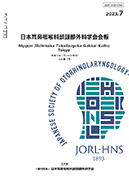Volume 126, Issue 7
Displaying 1-11 of 11 articles from this issue
- |<
- <
- 1
- >
- >|
Review article
-
Article type: review-article
2023 Volume 126 Issue 7 Pages 827-831
Published: July 20, 2023
Released on J-STAGE: August 01, 2023
Download PDF (2519K) -
Article type: review-article
2023 Volume 126 Issue 7 Pages 832-837
Published: July 20, 2023
Released on J-STAGE: August 01, 2023
Download PDF (10552K)
Original article
-
Article type: Original article
2023 Volume 126 Issue 7 Pages 838-843
Published: July 20, 2023
Released on J-STAGE: August 01, 2023
Download PDF (1230K) -
Article type: Original article
2023 Volume 126 Issue 7 Pages 844-851
Published: July 20, 2023
Released on J-STAGE: August 01, 2023
Download PDF (525K) -
Article type: Original article
2023 Volume 126 Issue 7 Pages 852-858
Published: July 20, 2023
Released on J-STAGE: August 01, 2023
Download PDF (905K) -
Article type: Original article
2023 Volume 126 Issue 7 Pages 859-862
Published: July 20, 2023
Released on J-STAGE: August 01, 2023
Download PDF (791K) -
Article type: Original article
2023 Volume 126 Issue 7 Pages 863-870
Published: July 20, 2023
Released on J-STAGE: August 01, 2023
Download PDF (614K)
Training lecture
-
2023 Volume 126 Issue 7 Pages 873-876
Published: July 20, 2023
Released on J-STAGE: August 01, 2023
Download PDF (635K)
Skill up lecture
-
2023 Volume 126 Issue 7 Pages 877-879
Published: July 20, 2023
Released on J-STAGE: August 01, 2023
Download PDF (474K)
ANL Secondary Publication
-
2023 Volume 126 Issue 7 Pages 880-881
Published: July 20, 2023
Released on J-STAGE: August 01, 2023
Download PDF (304K) -
2023 Volume 126 Issue 7 Pages 882-883
Published: July 20, 2023
Released on J-STAGE: August 01, 2023
Download PDF (173K)
- |<
- <
- 1
- >
- >|
